Public Pier — No Fishing License Required
This small pier juts out from the artificial Oyster Point Peninsula, a landfill area. As such, it serves as another lesson for what has happened to much of San Francisco Bay.
Looking towards shore from the end of the pier you’ll see the Oyster Point Marina to the right and a cove between two points of land off to the left. Looking past the water of the cove to the left you’ll notice that the shoreline has areas that appear to be white. This is the original shoreline which existed before these artificial peninsulas were built. The white is the remains of oyster beds and shells (although I’m not sure if these were the original small native oysters or the larger, more valuable “Eastern” oysters introduced by man and commercially grown for nearly 40 years).
This was once a tremendously rich area of water and one which still presents oysters and shelf areas from which to fish (if you know where they are). But nowhere is the fertility anything like it was back in the “olden” days — times, for instance, like the 1890s when Jack London sailed these waters on his sloop the Razzle Dazzle and gained the title he cherished, “Prince of the Oyster Pirates.” Man has shaped and reshaped the shoreline of the bay to meet his needs and these needs often differ from the needs of the true bay inhabitants: the fish and other wildlife which were common to these waters long before the coming of man.
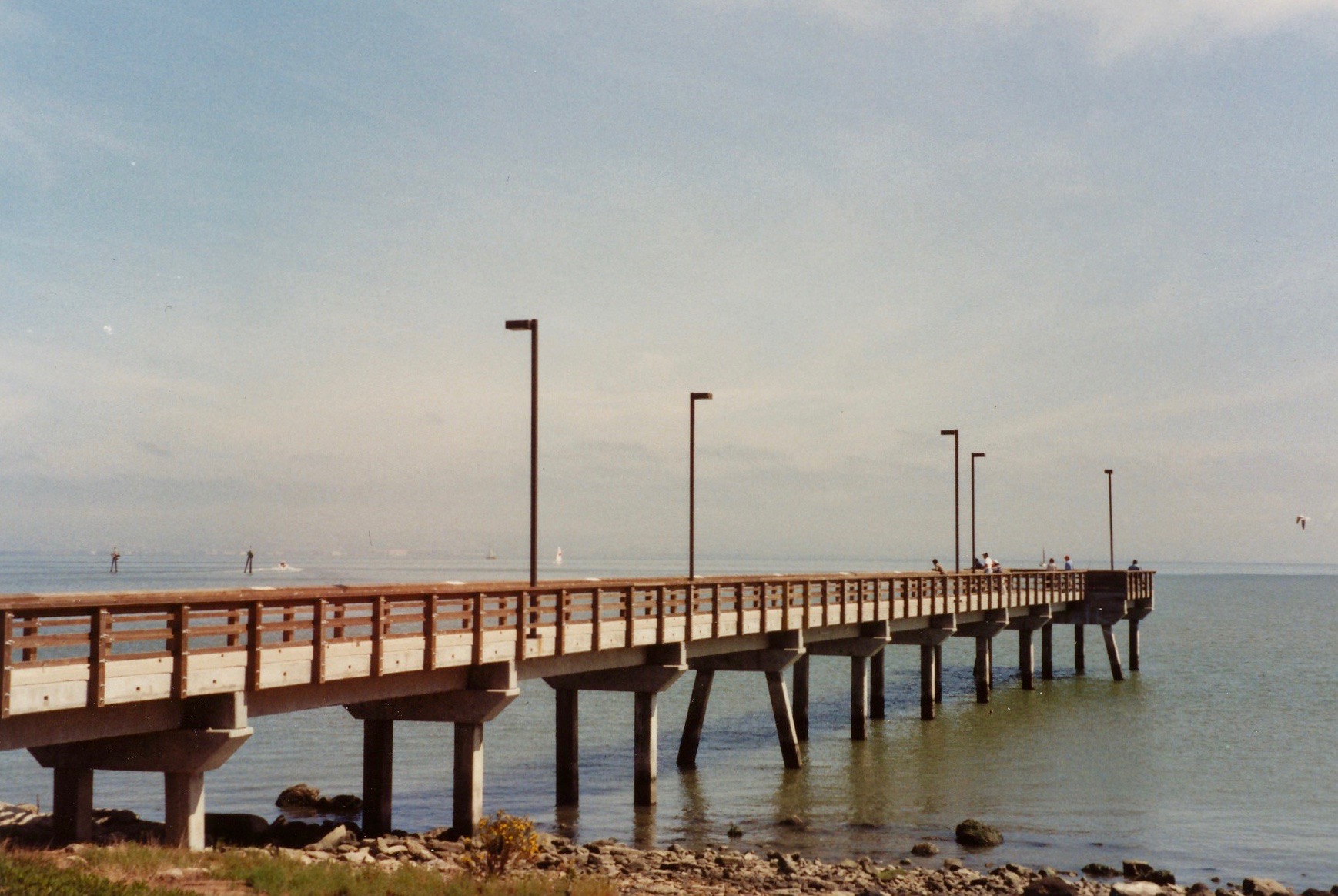
Environment and Fish. The pier is small, being only 170 feet long, and sits primarily over a mud bottom. The water here is fairly shallow but receives a good tidal movement as the water sweeps around the rock-studded point upon which the pier sits. As such, it is the type of area favorable to topsmelt and jacksmelt which are two of the main types of fish taken here.
It is also an area which sees many sharks, primarily small brown smoothhound sharks, but also a lot of leopard sharks, bat rays and a few skates. To the north of the pier sits a marina and shipping lanes, but neither appears to have much influence on the pier itself. Inshore, there are some rocks around the shallower waters; as a result, this area will seasonally yield a few seaperch and generally it is the best area for striped bass. Pilings themselves are concrete and have little growth on them even though the pier has been here since 1983.
Green moss can be a problem, especially during the late summer and fall months. At times the moss covers the bottom around the pier and makes fishing almost impossible. At other times the moss is growing further out in deeper water and doesn’t present a problem until the incoming tide begins to bring patches of the moss inshore. Pretty soon every cast yields a sinker covered with moss; hooks and bait are enveloped in the green hair; and your line itself begins to attract the moss. When such conditions arise it’s time to leave — although the moss doesn’t seem to faze some of the regulars. I have primarily noticed these concentrations of moss during late summer visits. This can also be a very windy spot so always bring a jacket with you to the pier.
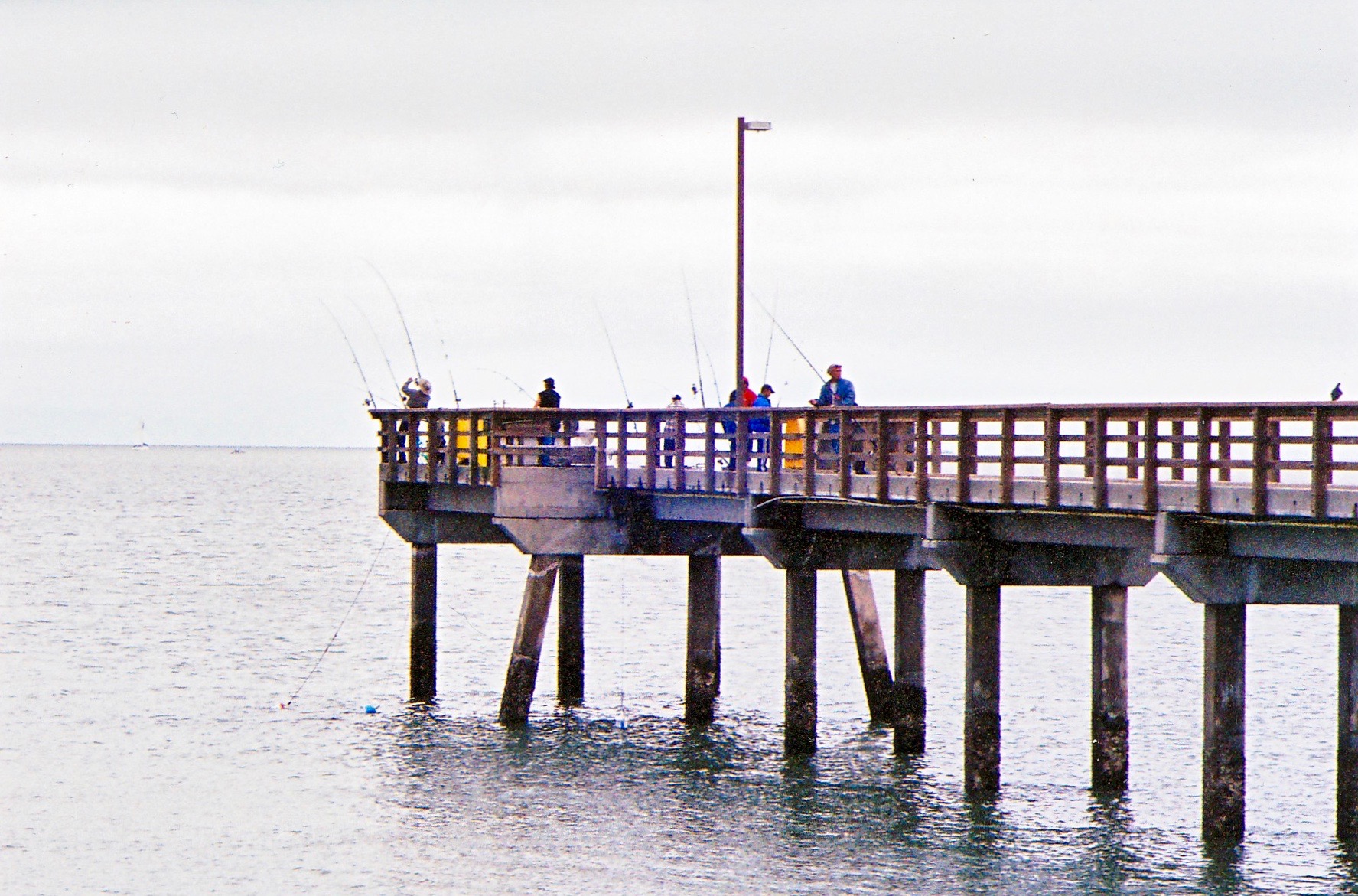
Fishing Tips. This pier is a favorite of shark anglers so you might want to concentrate on sharks. Bring a heavier rod and reel, 20-40 pound test line, and heavy leaders (even wire leaders). Use live midshipmen, squid, or an oily fish such as mackerel or sardine for bait, and cast out to the right or left from the end of the pier. Large leopard sharks are the favorite quarry, but brown smoothhounds are more common. Occasionally a 7-gill shark will also be caught but most of these are babies, not the monster-size adults.
A second alternative would be to fish the top of the water with a multi-hook jacksmelt rigging (remember: no more than three hooks in the bay). Fish mid-pier to the end on the side of the pier from which the water is flowing away. Use small pieces of pile worms or shrimp and small size 8-6 hooks.
Fish under and around the pier with a high/low leader, size 6-4 hooks, and small strips of anchovy for silver surfperch and walleye surfperch; cast further out for white croaker (kingfish).
Fish the inshore area in the winter to spring, using a high/low leader, size 6 hooks, and pile worms or grass shrimp as bait to catch black seaperch, rubberlip seaperch, pileperch, white seaperch and an occasional redtail surfperch.
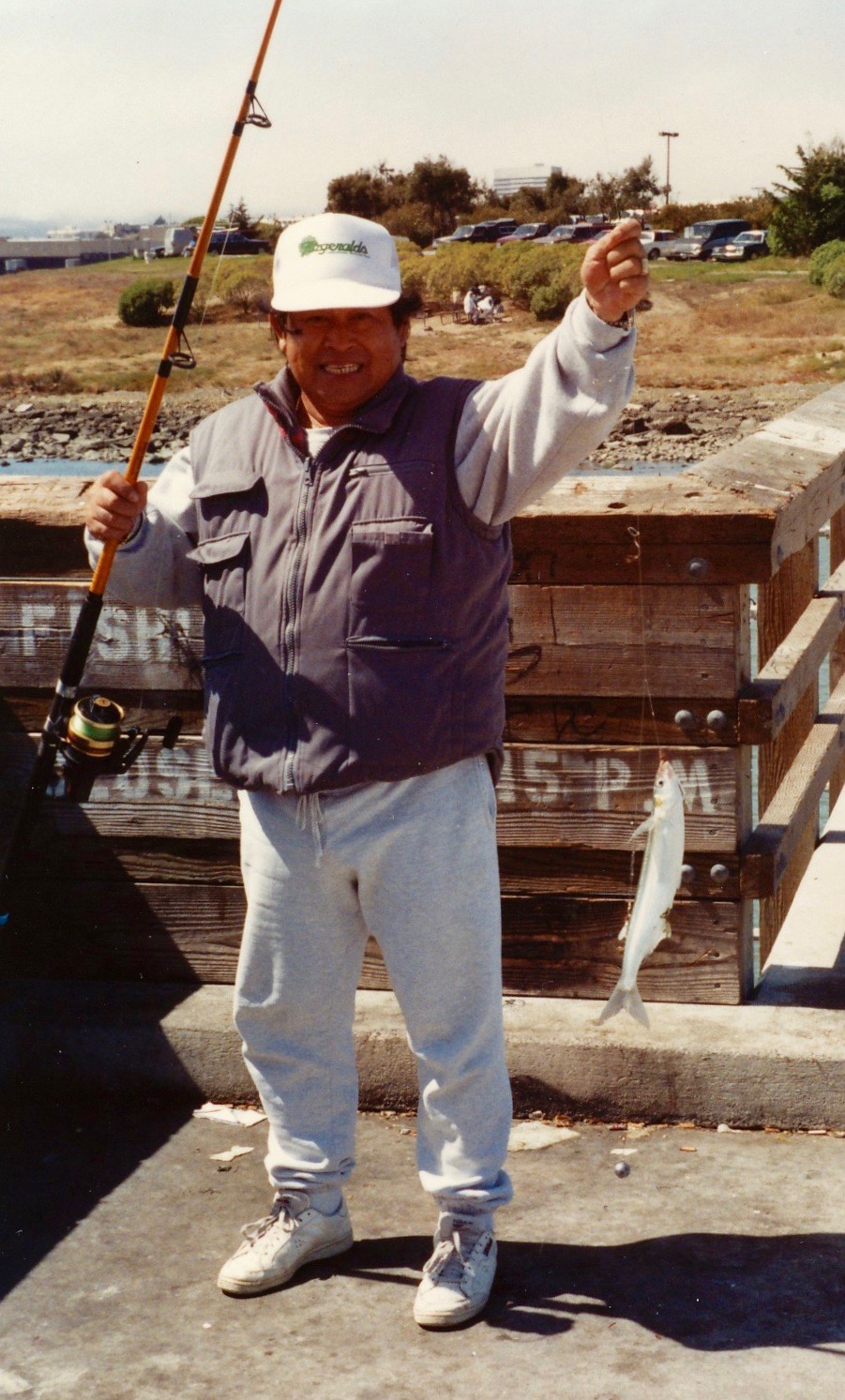
Jacksmelt
As at the two piers to the north, fishing for starry flounder from late January to March may yield a fish or two although the number of the starries has seemingly been going down for quite a few years. The best bait for flounders will be grass shrimp, ghost shrimp or cut anchovies fished on the bottom with a flounder rigging. Similar rigging in the spring to fall months may yield a halibut but most halibut will be caught on live bait, i.e., a small smelt or shiner perch used in conjunction with Carolina-type rigs.
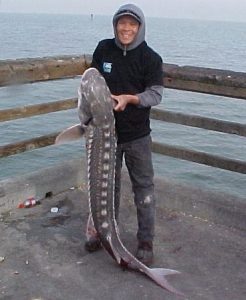
“Stan The Man” Low and a white sturgeon
May to September will often yield striped bass. Live bullheads (staghorn sculpin), shinerperch, and small smelt are the ideal baits for the stripers but grass shrimp, pile worms, and frozen anchovies will also yield some fish. Some anglers prefer using artificial lures for the stripers with a variety of lures attracting Mr. Linesides—Hair Raisers, spoons like Kastmasters and Krocodiles, top water lures like Pencil Poppers and Rapalas, and soft bait lures all yielding fish. Although the time to fish most piers is just before and after the high tide, this pier really seems to produce the most fish on the outgoing tide. Nighttime is also often the prime time for the stripers. Sometimes a summer or fall day will seem almost dead with few fish being caught. Then, when the sun begins to go down, the stripers go on the prowl around the pier and the regulars with the know-how will be waiting for them. I’ve heard tales of anglers catching over a dozen fish in one evening with most of the fish being over ten pounds in size.
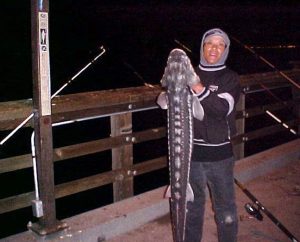
Another sturgeon caught by “Stan the Man” Low
The favorite fish at the pier is probably white sturgeon, a species most common in the winter and spring months, and one that often shows up the same time as the local herring spawns. The sturgeon like to vacuum up the eggs from the bottom and luckily for local anglers will also ingest a few riggings presented with the proper baits. I have seen the pier surrounded by boats and witnessed multiple hookups taking place both on the boats and on the pier. Action isn’t always that fast but it does happen. Timing is the key and during the right months it is critical to keep in touch with local anglers or bait shops so that you can find out when the runs begin. Also, remember to bring the right baits and the “au natural” choice would be herring and/or herring eggs during these times. It’s also good to bring along a buddy to help you net the fish that you hook since it is very tough to bring a large sturgeon up onto a pier. Lastly, remember to follow the rules; the only legal size sturgeon are those between 40-60 inches.
ALWAYS bring a net! A 38-pound halibut, large striped bass, leopard sharks over 40 pounds in weight, and bat rays, sturgeon, and 7-gill sharks approaching and even exceeding 100 pounds have been reported from the pier.
The Pier Rats Speak
Date: April 18, 1999; To: Ken Jones; From: Lea Mopia; Subject: Oyster Point Report
My husband brought home a very large striped bass (the biggest I’ve ever seen in my life) about two feet long I guess, 3 leopard sharks, 2 bat rays, 2 kingfish, and a sturgeon from Oyster Point. We are still newbies with this sport and I’d like to thank you for all the information tat we get from your site, it helps us a lot.
Date: August 2, 1999; To: Pier Fishing In California Message Board; From: Matt S; Subject: HELP!!! BIRDS ARE BECOMING A MAJOR PROBLEM!!!
Those large black loons or whatever are causing a very scary and frustrating problem. I have been fishing Oyster Point a lot, and every time I am there, there are hundreds of those things flying low and close to the pier in formations of about 3-45 birds a group. Every trip, a couple knock into my lines and pull my rods to just barley going over. Luckily I have learned to loosen the drag but I still end up losing a lot of line, tackle and bells. They are difficult to untangle and they have one hell of a bite. Anyone have any suggestions for a solution or defense against these interesting yet pesky creatures?
Posted by mjonesjr
You really want to get rid of the birds? Simply find a compressed air horn. You will find them at most marine stores and most well stocked hardware stores. The next time those birds come to close for comfort. Lay on the horn for a couple of seconds and I’ll bet you dollars to donuts those birds won’t know what hit them and it’s a safe way to ward them off. Hope this helps.
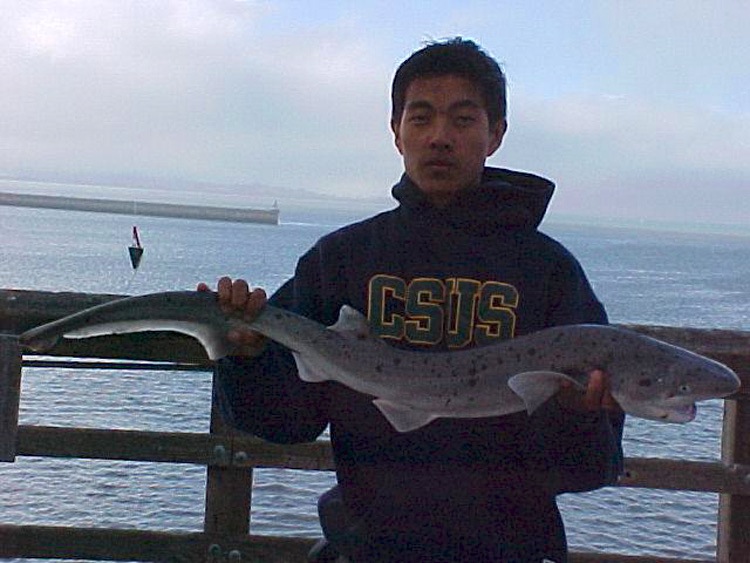
Matt S with a small 7-gill shark
Date: March 24, 2000; To: PFIC Message Board; From: Matt S; Subject: Hooked a freight train at Oyster Point
Went fishing at Oyster Point for the evening. Was there for a few hours without a hit at all, and all of the sudden, a fish hit and started peeling line off faster than I’ve ever seen before. I grabbed my rod and I instantly felt the power of the fish. I have a 10-ft Ugly Stick filled with 350 yards of 45 lb. Spiderwire Fusion, and the fish tore 310 yards in 15 seconds. There was nothing I could do but hold on and finally, I had about 10 yards of line left and it snapped cleanly. Everyone and myself estimate this to be a HUGE sturgeon, because normal rays fight differently and don’t take line as fast as this one did. Anyone have you any suggestions to how I could better prepare for this, so I don’t lose another sturgeon since I haven’t even got one yet?
Posted by Songslinger
Wow, a monster! Could well be a sturgeon; I’ve had them go off suddenly like that without so much as a twitch of the rod tip beforehand. Also possible is a big shark. There have been some huge 7-gill in the Bay recently, up to 90 pounds. Don’t know about you, but I think it’s kind of cool when I get spooled by a big guy. Sure beats no action at all!
How was your drag set? Too loose and you let out too much line right away and give the fish a head start and momentum that is hard to halt. Too tight and the line snaps. The idea is too tire out the fish, make him work when he’s pulling out your line, and get him to turn your way. Basic stuff, but it’s always good to review.
And some times there just isn’t much a shoreliner can do. I don’t know whether there was anything you did that was “wrong” in this case, Matt. There is certainly nothing wrong with your gear. You have sufficient resources to fight a large fish. It was a tough break. Fish happens…
Posted by Ken Jones
I’ve seen you fish and heard enough of your reports to feel that you are, by now, a pretty proficient fisherman. Unfortunately there are times when you can lose them even when you’ve followed the 7 p’s. Chalk it up to experience and hope you get another chance at the big ‘un. By the way, it’s always kind of interesting to wonder what the big one was when it gets away. Was it a leviathan-like sturgeon weighing several hundred pounds (recently one was caught in the Delta); was it a giant 7-gill shark (or even a 6-gill); maybe a baby gray that has wandered into the wrong part of the bay; or perhaps a naval submarine out on a secret inner-bay maneuver? We’ll never know.
Date: April 10. 2002; To: Pier Fishing in California Message Board; From: geckomd; Subject: Oyster Point…
Checked out Oyster Point from 12:00 to about 2:30 PM. Lots of people fishing at the end. Saw a couple of small rays (maybe about 24-30 inches across…) landed and released. One of the guys hooked on something that took him from the south end of the pier, around the pier and onto the rocks in front of the bait shop. After about a 20-30 minute battle the line snapped. Not sure whether it was a ray or a dino since it never surfaced but it did put up one heck of a fight. Saw Batman himself. Except he was too busy casting a net for bait in the middle of the pier. There were lots of sardines in the area and Stan and a couple of other guys netted buckets after buckets of live sardines for everyone on the pier. Birds were also diving about 100 feet off the end of the pier. However, no hallies were landed while I was there. Did talk to one of the guys there and he reported that about a dozen or so hallies were landed on the weekend. He said that he himself landed a 40” butt on Sunday as well and had to come back out again to try for more. Who can blame him. That’s one tasty catch!
<*}}}}}}}}}>< — Special Bay Area Regulations:
- A perch closure exits in San Francisco and San Pablo Bay from April 1 to July 31. No perch may be kept other than shinerperch (20).
- In San Francisco and San Pablo Bay a fishing line may not contain more than three hooks.
Sturgeon Regulations:
- A sturgeon report card and tags are required for anyone fishing for or taking sturgeon. (a) The card must be in the angler’s possession; (b) a tag must be used for any sturgeon retained by the angler; (c) the angler must record information on the Sturgeon Report Card immediately after catching and keeping or releasing the sturgeon.
- White sturgeon can only be kept from 40-60 inches; larger and smaller sturgeon must be released.
- Green sturgeon may not be taken or possessed.
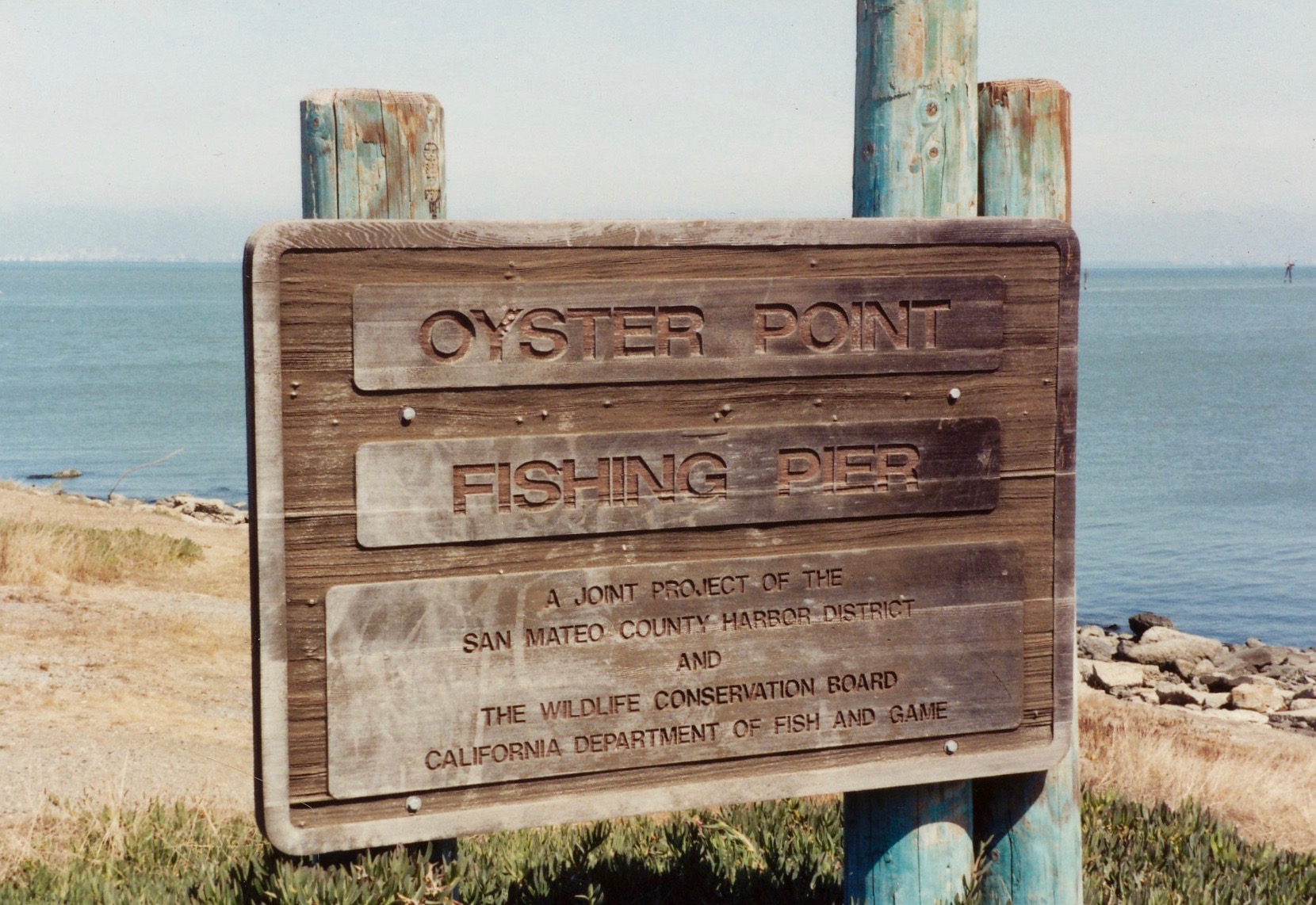
Oyster Point Fishing Pier Facts
Hours: Open from 6 A.M. to 10 P.M.with signs on the pier saying closure at 9:40 p.m.
Facilities: Restrooms are located on land at the front of the pier. There are lights and a fish cleaning station on the pier. There are no food facilities or bait and tackle available. Limited free parking.
Handicapped Facilities: Handicapped restrooms but no handicapped parking. Accessible by wheelchair and crutches. Not posted for handicapped.
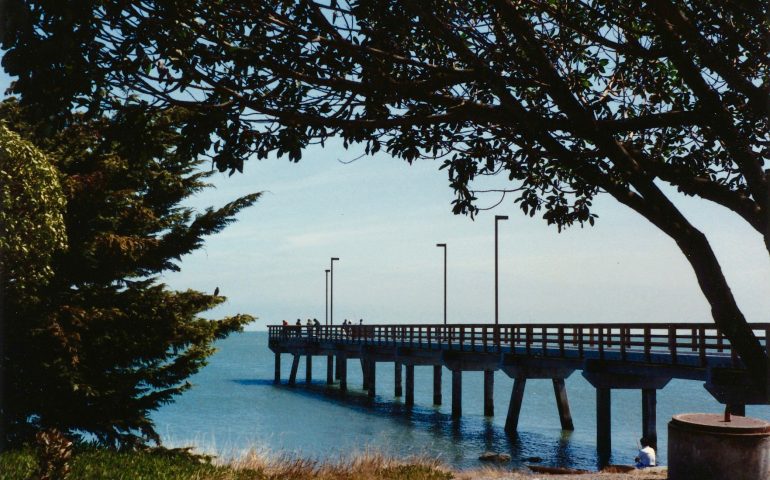
Is crabbing allowed at pier in Oyster point?
Yes but you can only keep rock crabs.
Oyster Point Fishing Pier in South San Francisco is a fantastic spot for anglers looking to catch a variety of fish while enjoying breathtaking views of the bay. The pier offers a peaceful escape and ample space for fishing, making it a popular destination for both seasoned fishermen and beginners. To ensure your fishing equipment and boats are always in top condition, consider using remote grease manifold line kits. These kits provide efficient lubrication to machinery, allowing your gear to perform smoothly during every fishing trip, so you can focus on enjoying your time at Oyster Point.
The Oyster Point Fishing Pier in South San Francisco is a serene spot perfect for relaxing and enjoying nature. Just like using a font change online tool to enhance the appearance of your text, visiting this pier enhances your day with stunning views, fresh air, and the joy of fishing. It’s a beautiful escape for anyone looking to unwind and connect with the outdoors
“Oyster Point Fishing Pier in South San Francisco is a perfect spot to relax and reel in some great catches—just like the thrill of Nulls Brawl APK! ‘Har cast ek naya adventure, har brawl ek naya challenge!’ Whether fishing or gaming, patience and skill always pay off!”
“Oyster Point Fishing Pier in South San Francisco is a great spot for relaxing by the water and catching some fish! After a day outdoors, unwind with some epic battles—Download Nulls Brawl APK and enjoy unlimited fun!
Oyster Point Fishing Pier in South San Francisco is a perfect spot to relax, fish, and enjoy stunning waterfront views. Whether you’re an angler or just love peaceful scenery, this place is a must-visit! And if you’re a fan of heartfelt poetry, visit this site for beautiful shayari on Pureshayari that captures emotions like the waves of the ocean.
Nothing beats a day at Oyster Point Fishing Pier in South San Francisco—fresh air, great views, and the perfect meal from Sonic Menu With Prices to top it off! Whether you’re fishing or just relaxing, a delicious bite makes the experience even better.
Whether you’re fishing or just taking in the serene views at Oyster Point Fishing Pier,
a delicious meal from Sonic Menu With Prices makes it all even better.
And much like the (Pakistan and Saudi Arabia time difference,){https://prayertimesksa.com}
the right timing can turn a simple outing into a perfect day.
Visit here to learn more about top pier fishing destinations.
Oyster Point Fishing Pier in South San Francisco is a great spot for fishing and relaxing by the water! While enjoying the sounds of the waves, make sure your hearing is at its best with Mackayears Reviews—trusted insights on expert ear care!
Oyster Point Fishing Pier in South San Francisco offers a peaceful retreat where you can soak in nature’s beauty. Much like how an online font changer can refresh your text’s look, a visit to this pier refreshes your spirit with scenic views, crisp air, and the calming experience of fishing. It’s the perfect getaway for anyone needing a quiet moment to relax and reconnect with the outdoors.
Oyster Point Fishing Pier in South San Francisco is a peaceful escape where you can unwind and take in nature’s beauty. Just like a quick refresh with an online tool, even spending five quiet minutes by the water can clear your mind. Need a moment to reset? Use this 5-minute timer to make the most of it.
Letterbox NYT is a clever word puzzle where you connect letters from the edges of a box to form words. It features a unique letter grid, unlimited attempts, daily challenges, and encourages creative thinking. Great for anyone who loves a fun brain workout!
Oyster Point Fishing Pier is a serene spot perfect for relaxing and capturing scenic views. If you’re sharing your experience on Threads, don’t forget to use thread video download to save your favorite moments and relive them anytime offline!
Oyster Point Fishing Pier is a peaceful spot to relax and enjoy nature, but behind the scenes, places like this rely on solid infrastructure. Thanks to Pasco County Electrical Services, local amenities and lighting systems are maintained efficiently, keeping the area safe and enjoyable for everyone.
Oyster fishing videos are fascinating to watch on YouTube. I like to save the best ones to watch offline later using this tool: visit here
Catching the perfect print is a lot like pier fishing—patience, precision, and the right setup make all the difference.
Oyster Point Fishing Pier in South San Francisco is such a peaceful spot — perfect for a calm morning or sunset view. I always bring one of my Dutch Bros protein drinks with me when I go. It keeps me energized while I fish or just enjoy the breeze. Seriously, there’s nothing like sipping on a cold, creamy protein coffee while watching the water. Total vibe!
Great write-up! I’ve been thinking about trying out Oyster Point Pier and this guide gave me exactly what I needed. Thanks for the tips and the detailed fish list super helpful!